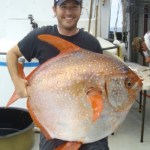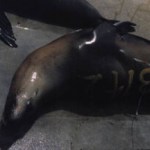ocean
Image of yellowfin tuna via Wikimedia Commons.
I love fishing. As with every fisherman, I have my fair share of "the one that got away" stories steeped in *mostly* truth. So, you can imagine my interest in reading research that shows fish appear to be shrinking in warming waters.
Warm waters carry less oxygen, which makes it difficult for fish to breath...especially larger fish. Metabolism is also higher in fish living in warm waters. Higher metabolism means the fish need more oxygen. The gills of fish are responsible for extracting oxygen from water and when they reach their maximum…
By now you have probably seen the video showing the discovery of a strange purple blob during an exploration off the coast of California. As a scientist what do you do when you find something new? You bring it back to the lab of course. Although it may take years to identify what it is, the researchers have speculated it might be some new species of soft-bodied mollusk. Check out the newly uploaded YouTube video:
Image of elephant fish by fir0002 | flagstaffotos.com.au Canon 20D + Tamron 28-75mm f/2.8 - Own work, GFDL 1.2, https://commons.wikimedia.org/w/index.php?curid=864471
Seawater contains sulfate concentrations that are nearly 40 times those measured in plasma. Therefore, it is easy to see why fish would need to develop mechanisms to keep sulfate within a physiologically normal range. The kidneys of teleost fish have been known to excrete excess sulfate in the urine. However until now, it was not known whether the kidneys of cartilaginous fish do the same thing as their…
Left Top: Pacific hatchetfish; Left Bottom: longfin lanternfish; Right: an acoustic instrument in the Pacific Ocean. (Images from Scripps Institution of Oceanography press release)
I love a good mystery. This one has puzzled scientists for several years now...ever since they discovered a humming or buzzing noise in the Pacific ocean, an otherwise rather quiet place. This was no ordinary noise, that they knew of. In a recent interview on NPR, Dr. Simone Baumann-Pickering, Scripps Institution of Oceanography (La Jolla, California) shared what she and her team think is causing all that noise…
The World Meteorological Organization has announced that they expect 2015 to be the warmest year on record, and that we are in the warmest five year period on record. We are speaking here of global surface temperatures, though similar descriptions probably apply to the upper 2000 meters or so of the ocean as well.
The global average surface temperature in 2015 is likely to be the warmest on record and to reach the symbolic and significant milestone of 1° Celsius above the pre-industrial era. This is due to a combination of a strong El Niño and human-induced global warming, according to the…
Research published July 3 in the journal BMC Evolutionary Biology supports the idea that some species of spiders can catch the wind to "sail" across bodies of water, which they suggest might be why certain spiders seem to be all over the world. While some spiders were already know to catch the breeze to travel by air relatively short distances, and some are known to be aquatic, the researchers in this study were interested in examining just how well spiders could actually walk on water. So, they collected 325 wild spiders and dropped them on water to see what…
Nick Wegner (Southwest Fisheries Science Center) is pictured here holding an opah. Image Credit: NOAA Fisheries, Southwest Fisheries Science Center
The opah (Lampris guttatus), otherwise known as a moonfish, lives in the deep sea where warm blood can be advantageous. According to a quote from Nicholas Wegner (NOAA) posted in Live Science, "Increased temperature speeds up physiological processes within the bod. As a result, the muscles can contract faster, the temporal resolution of the eye is increased, and neurological transmissions are sped up. This results in faster swimming speeds…
Few fish can survive the immense pressure of living in the deep sea. The Mariana Trench can reach around 36,200 feet deep with pressures of over 1,000 atmosphere. Scientists have placed landers at various depths ranging from 16,400-34,750 feet along the walls of the trench and have discovered what appears to be the "World's Deepest Fish". The fish was found at 26,872 feet which is estimated to be near the lower limit for bony fishes (of 27,600 feet). This newly discovered fish has what look like wings and tentacles. The video below was captured by the Hadal Ecosystem Studies expedition (HADES…
Ever wonder what lies beneath the polar ice? Turns out several researchers did as well. This past July a team of scientists led an expedition designed to image life under sea ice. The video below was captured with the Nereid Under Ice (NUI) vehicle and shows brown algae living on the bottom of sea ice as well as larvaceans, which are filter-feeding tunicates. The advantage of the new vehicle is that it can travel very far (the spools of cable are ~40 km long) and allows researchers to create maps and collect samples. Researchers are hoping to explore greater distances in future dives that…
With the help of advice from a manicurist, Dr. Kate Mansfeld (University of Central Florida) has come up with a way to track hatchling sea turtles for the first time. After hatching, the turtles head straight for the ocean where they grow for about 10 years or so before returning to the same beach where they hatched. Until now, researchers have wondered how these juvenile turtles spent their time.
Source:
Scientific American
Image of seals from www.fanpop.com/clubs/the-animal-kingdom/images/14060694/title/seal-wall…
Paleogeneticist Dr. Johannes Krause (University of Tübingen, Germany) and colleagues were interested in the origin of tuberculosis (TB) in the Americas. Since strains of TB found in the Americas are related to strains found in Europe, prior theories held that Spaniards may have introduced it to the Americas while colonizing South America. The problem with those theories is that pre-Columbian skeletal remains showed signs of TB much earlier.
Dr. Krause was quoted in Scientific American, “…
In honor of the Discovery Channel's "Shark Week", check out these shark cams.
National Aquarium Reef Shark Cam:
Broadcast live streaming video on Ustream
SHARK FIN CAM: Video taken from a camera strapped to the dorsal fin of a shark:
Broadcast live streaming video on Ustream
If you have not yet tuned in to Discovery Channel, there are still a few days left of shark week!
Sounds kind of like an oxymoron doesn't it? Who knew sponges could be carnivorous? Scientists have described four new species of carnivorous sponges in a newly published article in Zootaxa. Check out this video from the lead author of the study, Lonny Lundsten who is a Senior Research Technician at the Monterey Bay Aquarium Research Institute:
Lundsten L, Reiswig HM, Austin WC. Four new species of Cladorhizidae (Porifera, Demospongiae, Poecilosclerida) from the Northeast Pacific. Zootaxa. 3786 (2): 101–123, 2014.
Credit: Image courtesy of Stanford University Medical Center, from ScienceDaily
According to a press release from Stanford University, California sea lions develop epilepsy from exposure to a toxin produced by algae called domoic acid. The animals develop seizures which can result in memory loss, tremors, convulsions and even death. The hippocampal region in the brain of the affected sea lions shows similar damage as humans with epilepsy, with losses of about 50 percent of neurons. Dr. Paul Buckmaster, professor of comparative medicine at Stanford was quoted as saying, "We found there was…
Dr. Carl Meyer (University of Hawaii) and Dr. Katsufumi Sato (University of Tokyo) have teamed up to gather data about shark behavior in a rather interesting way. They flipped the animals upside down, which makes them relax, and strapped on cameras and instruments that will facilitate the creation of 3D models of shark movements. Using accelerometers, they are able to measure speed while magnetometers record the magnetic field and additional tools measure the water temperature and depth. The video is used to help contextualize these other data.
Sources:
University of Hawaii
National…
Amazon Prime Air might want to pay attention to this research. Scientists have studied the flight patterns of albatrosses to understand how the animals are able to sustain flight with minimal energy expenditure.
"Let us leave this place where the smoke blows black
And the dark street winds and bends.
Past the pits where the asphalt flowers grow
We shall walk with a walk that is measured and slow,
And watch where the chalk-white arrows go
To the place where the sidewalk ends." -Shel Silverstein
No, there's not really an edge to our world, but if you've ever been to the ocean shores, you might know that feeling I'm talking about. The smell of the salt water, the wind gusting in from the sea, the sandy beaches and rocky outcrops slowly losing ground to the relentless waves; it's one of the most…
Dr. Barbara Block from Stanford University, a well-known comparative physiologist and member of The American Physiological Society, has been in the news recently for her work tracking sharks. She has spent her career studying the physiology and migratory habits of ocean wildlife. In a prior blog, I talked about her work tracking bluefin tuna and posted an audio clip of an interview with her talking about how she measures their body temperature, heart rate, etc, using sophisticated tracking devices.
Now you can become part of her exciting ongoing research on shark behaviors through Shark Net,…
On January 15, 1961, the US coastguard raced through the darkness toward a tiny point 84 miles southeast of New York City. There, 28 crew members of Texas Tower 4 were waiting desperately to be evacuated from their station. As huge swells and high winds pounded the hull of the ship, their radios picked up a frantic transmission from the tower: "We're breaking up". And with that, Texas Tower 4 and all of its occupants were pulled beneath the waves.
Built in 1957, the five Texas Towers were intended to become part of the USA's advanced early warning system against Soviet bombers. Named for…
Here are some of the thoughts and questions that stayed with me from this session. (Here are my tweets from the session and the session's wiki page.)
Among other things, this panel took up the article panelist Lindsey Hoshaw wrote about the garbage patch for the New York Times and some of the reaction to it (including from panelist Miriam Goldstein).
Lindsey's article was interesting because of the process. To get a spot on the ship going out to the North Pacific gyre, where the garbage patch is, she had to come up with funding. (We learned during the session that ship time on some of…




